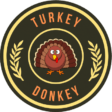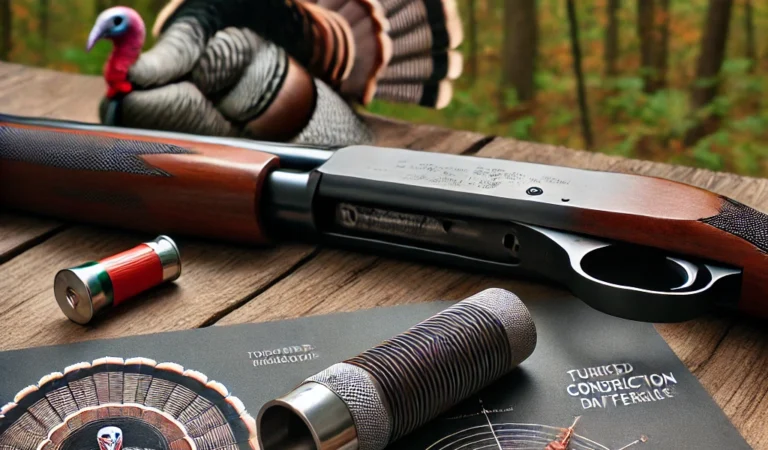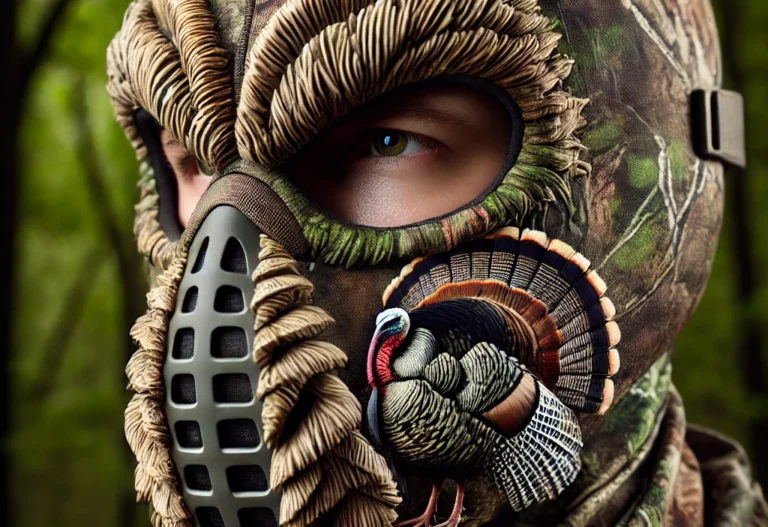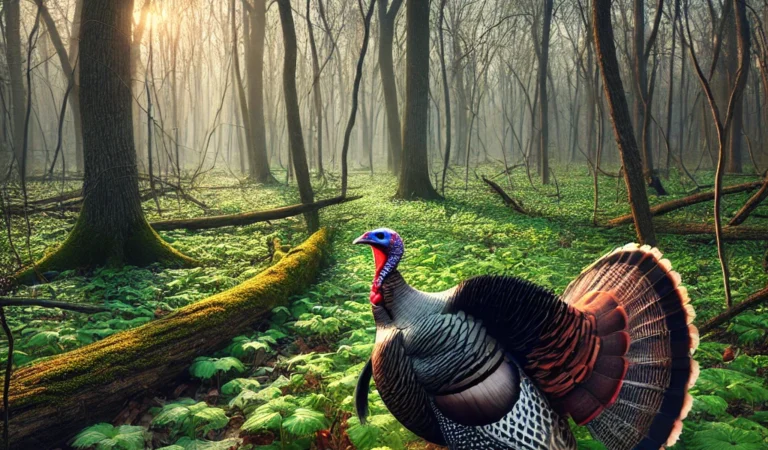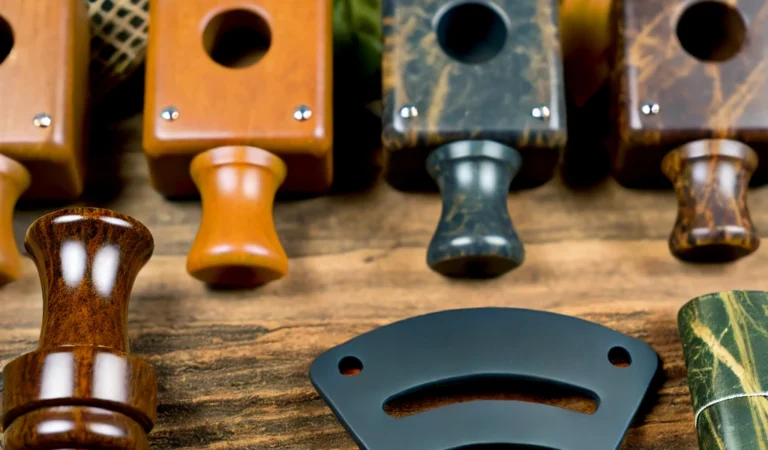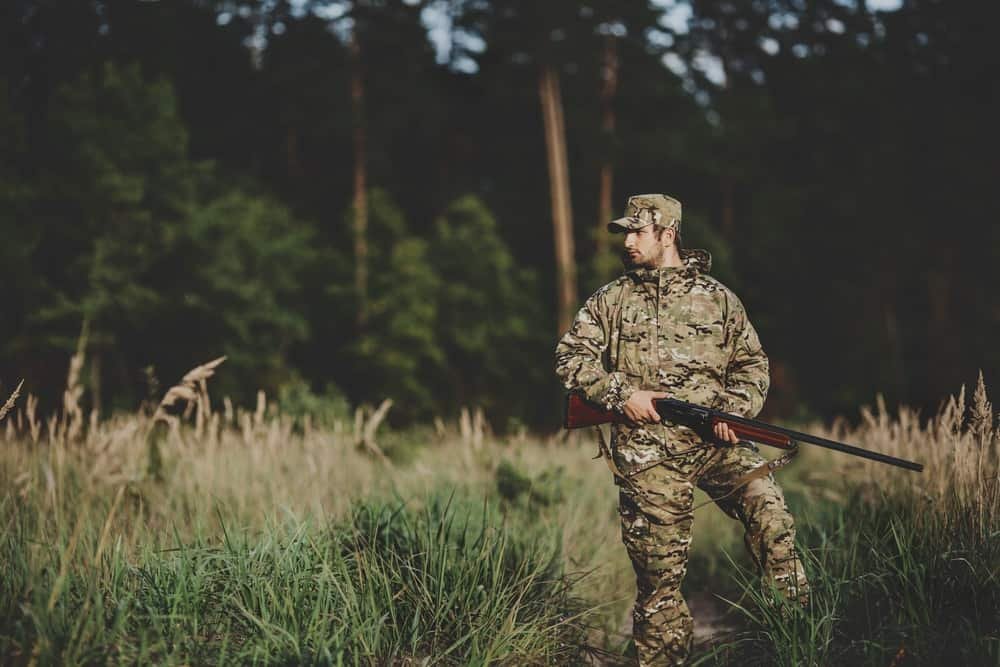Turkey Hunting with a Bow – 7 Expert Tips for Success
Turkey hunting with a bow represents the pinnacle of hunting challenges. It combines the ancient art of archery with the pursuit of one of nature’s most wary game birds. This thrilling endeavor demands a unique blend of stealth, precision, and unwavering patience from hunters. In this blog, we will cover how to shoot a turkey with a bow.
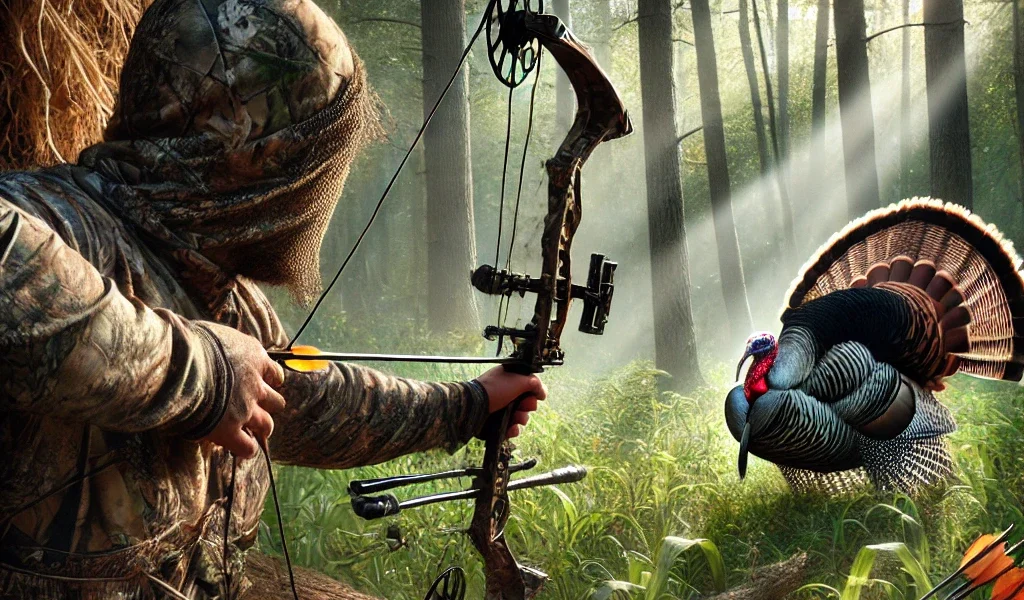
Unlike firearm hunting, bowhunting turkeys require hunters to draw incredibly close to their quarry, often within 30 yards or less, heightening the hunt’s excitement and difficulty.
The whisper-quiet draw of a bow, the heart-pounding moments as a turkey approaches, and the intense focus required to make an ethical shot create an unparalleled hunting experience.
For those who embrace this demanding form of turkey hunting, the rewards extend far beyond the harvest. They offer a profound connection with nature and a deep sense of accomplishment that comes from mastering one of hunting’s most formidable challenges.
Selecting the Right Bow and Arrows for Turkey Hunting
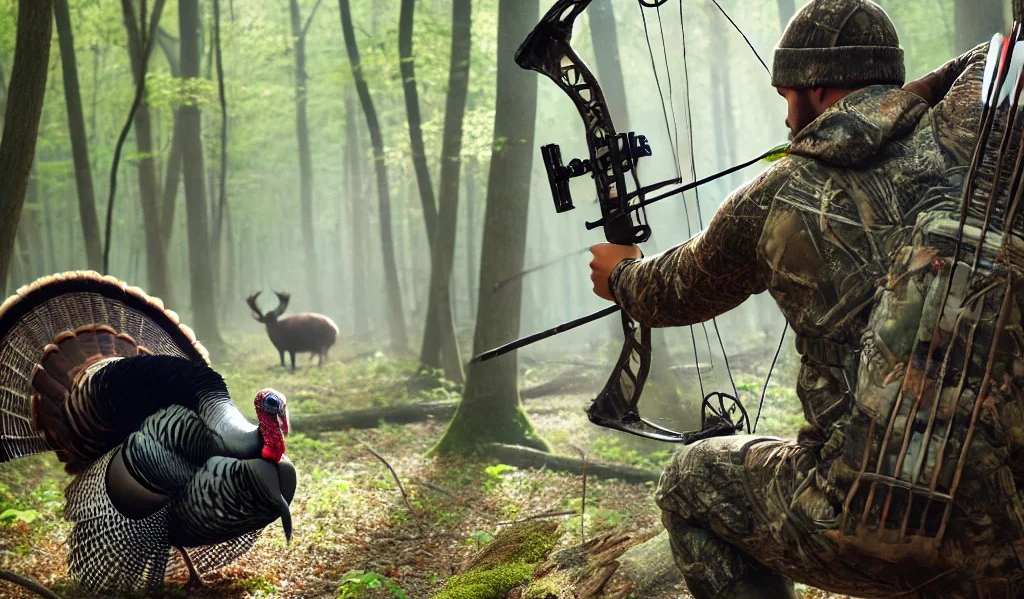
When it comes to turkey hunting, selecting the right equipment is paramount. The compound bow and recurve bow are the two main bows commonly used. Each has its advantages depending on the hunter’s preference and skill level.
The compound bow is popular among turkey hunters due to its modern design and advanced technology. It features a system of pulleys and cables that significantly reduce draw weight when fully drawn, allowing for better accuracy and ease of aiming.
This reduced weight at full draw is particularly beneficial when immediate shots are required, such as when turkeys suddenly appear within range. However, some hunters prefer using a recurve bow for hunting.
The simplicity of its design offers advantages such as quieter operation, lighter weight, and greater maneuverability in tight spaces like thick brush or dense forests.
Although drawing requires more strength than a compound bow, many seasoned hunters appreciate the challenge and enjoy honing their archery skills with this traditional weapon.
Choosing Appropriate Arrow Weight and Broadheads
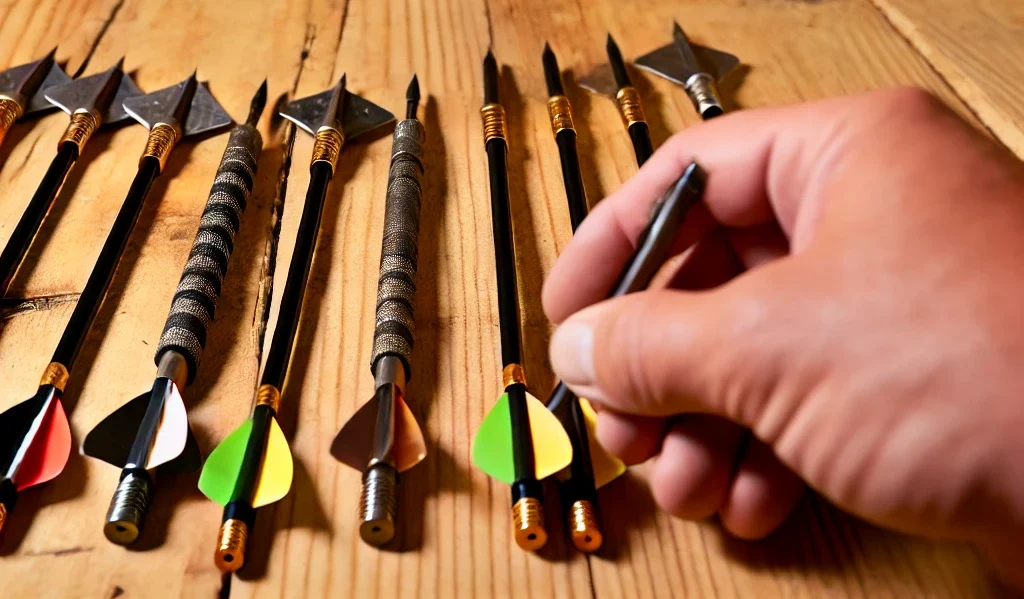
The appropriate arrow weight is crucial for maximizing accuracy and penetration when hunting turkeys with a bow. Heavy arrows are generally preferred as they have increased kinetic energy upon impact, ensuring better penetration through the turkey’s feathers and vital organs.
In addition to arrow weight, choosing suitable broadheads is essential for effective hunting. Broadheads specifically designed for small game or turkeys offer features such as wider cutting diameters (around 2 inches) that create large entry wounds necessary for quick kills.
Also important is choosing between mechanical broadheads (which open upon impact) or fixed-blade broadheads (with blades that remain exposed). While both types can be effective, practicing with the chosen broadheads is crucial to becoming familiar with their flight characteristics.
Mastering Archery Skills Specific to Hunting Turkeys
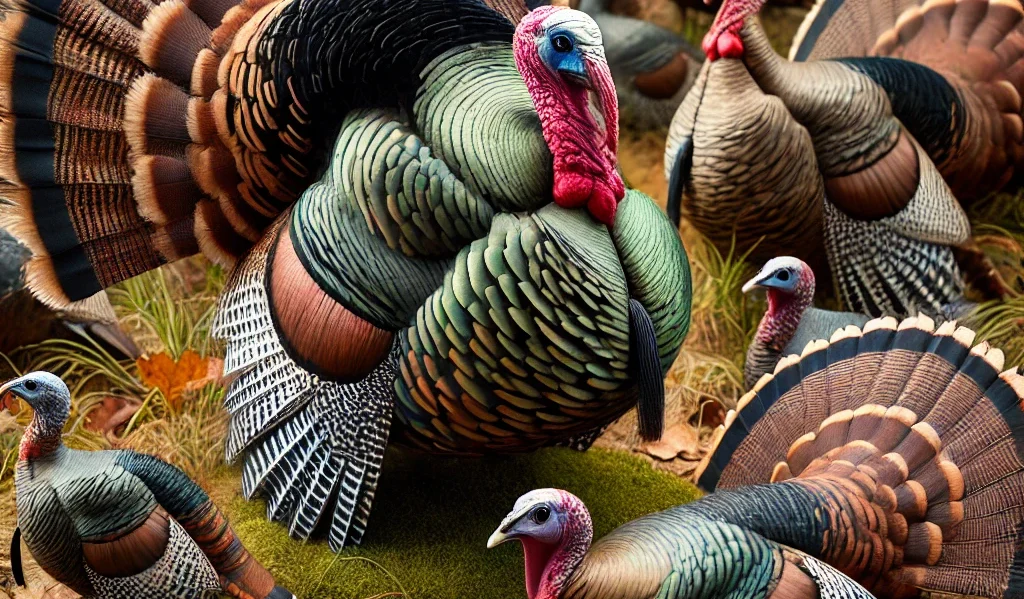
A successful turkey hunt requires mastering specific archery skills tailored to these elusive birds. One important technique is drawing your bow without being detected by the keen eyes of a turkey.
Practice slow and controlled movements, ensuring your draw is silent and smooth, minimizing any unnecessary motion that may alert nearby turkeys. Another crucial skill is aiming for vital areas in a turkey’s body.
Unlike larger game animals, turkeys have small vital zones, primarily consisting of the head and neck region. Practicing accurate shot placement by aiming at spots such as the base of the neck or just above where the feathers meet will greatly increase your chances of achieving clean kills.
Furthermore, practicing shooting from various positions is essential for adaptability in different hunting scenarios. Whether standing, kneeling, or sitting in a blind or natural cover, simulating these real-life situations during practice sessions will enhance your shooting skills and build confidence when faced with challenging hunting conditions.
Turkey Hunt Scouting Techniques

Bow Hunting Turkey Tips
Scouting is essential before embarking on a hunting expedition with a bow. Scouting helps you understand the local turkey population and their behaviors, enabling you to make informed decisions during the hunt.
One effective scouting method is conducting pre-season surveys by traversing potential hunting areas and looking for signs of turkey activity. Look for tracks in the dirt, scratched-up leaf litter indicating feeding areas, and scattered feathers that may suggest roosting sites.
Using trail cameras to monitor turkey movement patterns
Trail cameras have become invaluable tools for modern hunters, offering a non-intrusive way to monitor wildlife movement patterns. Placing trail cameras strategically along game trails or near known roosting areas can provide valuable insights into turkeys’ daily routines and habits in your hunting area.
Please set up your camera at a suitable height (around the waist or chest level) and angle it towards potential crossing points or food sources. By reviewing the captured images or videos, you can identify peak activity times, preferred travel routes, and even individual turkey behavior.
Identifying roosting sites and feeding areas through observation
Observation is another crucial element of successful scouting. Spend time glassing fields at dawn or dusk when turkeys are most active. Look for groups of turkeys flying up into trees as they prepare to roost for the night; this will give you an idea about potential roosting sites.
During daylight hours, observe their feeding patterns by carefully watching where they go to scratch for insects or browse for seeds or berries. Pay attention to areas with fresh droppings, tracks, feathers scattered around dust baths, or disturbed vegetation as indicators of active feeding zones.
Utilizing calls and decoys in scouting
Calls and decoys can significantly enhance your scouting efforts by attracting turkeys. They allow you to observe their reactions and learn more about their behavior. Different types of calls produce various sounds that imitate turkey vocalizations.
Diaphragm calls, operated by placing them inside the mouth, create realistic hen sounds like yelps, clucks, and purrs. Box calls produce raspy yelps and cuts when scraped against each other, while slate or pot calls mimic soft purrs or high-pitched yelps.
Bowhunting Turkeys
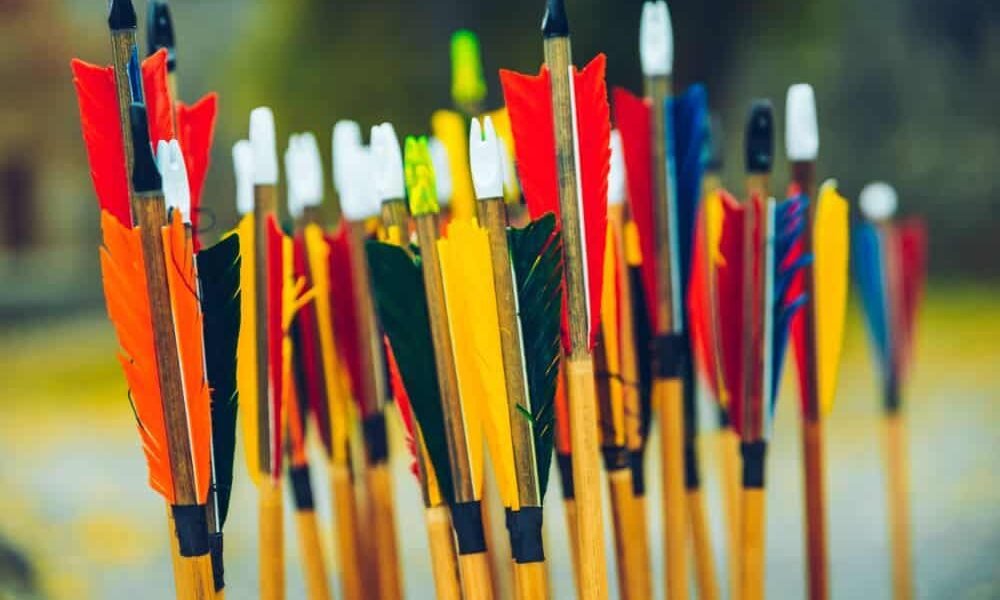
Stalking: Stealth and Precision in Pursuit
Stealth is the key to stalking turkeys with a bow. Moving silently and blending into the surroundings are crucial elements for success. Begin by carefully studying turkey behavior and identifying their roosting or feeding areas.
Approach the area slowly and quietly, always monitoring your surroundings for any signs of movement or disturbance. Walk softly, avoiding stepping on twigs or dry leaves that may indicate your presence.
As you close in on a roosted or feeding bird, use the terrain features to your advantage. Utilize natural cover like trees, bushes, or rocks to break up your silhouette and stay hidden.
Move incrementally from cover to cover while frequently pausing to observe the turkey’s behavior. Patience is essential during stalking; take every opportunity to move when the turkey’s head is down or turned away.
When you finally reach shooting range, remember that precision is key with a bow. Draw smoothly without sudden movements that could startle the turkey, ensuring a clean shot.
Aim at vital areas such as the neck or wing butt base for higher chances of an ethical harvest. With practice and patience, stalking can be an exhilarating hunting strategy for bow hunters seeking an up-close encounter with these majestic birds.
Setting Up Blinds: Concealment Tactics for Success
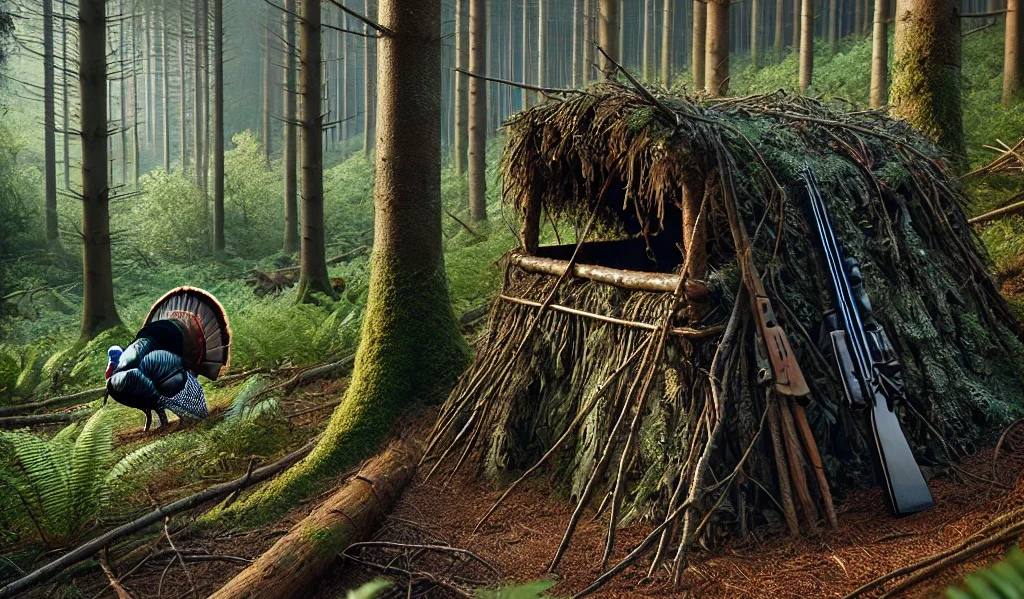
Setting up blinds allows bow hunters to create an effective concealed position to wait patiently for turkeys to come within range.
Proper planning and understanding of turkey behavior are essential when selecting locations for blinds. Firstly, scout potential areas where turkeys frequently visit, such as feeding fields or strut zones.
Look for well-traveled paths or scratching patches nearby that indicate regular turkey activity. Once you’ve identified such spots, please choose a location where you can set up your blinds with minimal disturbance to their routine.
Next, consider the concealment of your blinds. Opt for natural-looking blinds that blend into the environment seamlessly.
Camouflage patterns that mimic the surrounding foliage or brush offer excellent concealment. Additionally, ensure that your blind has enough shooting windows positioned strategically for clear shots at different angles.
Patience is vital when hunting for a blind. Settle in and remain still, avoiding unnecessary movements that could alert the turkeys to your presence.
Use turkey calls sparingly and intermittently to attract their attention without arousing suspicion. By employing effective concealment tactics and waiting quietly in a well-placed blind, bow hunters can increase their chances of a successful turkey harvest.
Conclusion: Turkey Hunting with a Bow

Bowhunting turkeys combines skill, patience, and an appreciation for the art of pursuit. Whether stalking turkeys on foot or meticulously setting up blinds, bow hunters engage in an immersive experience that connects them intimately with nature’s rhythms.
